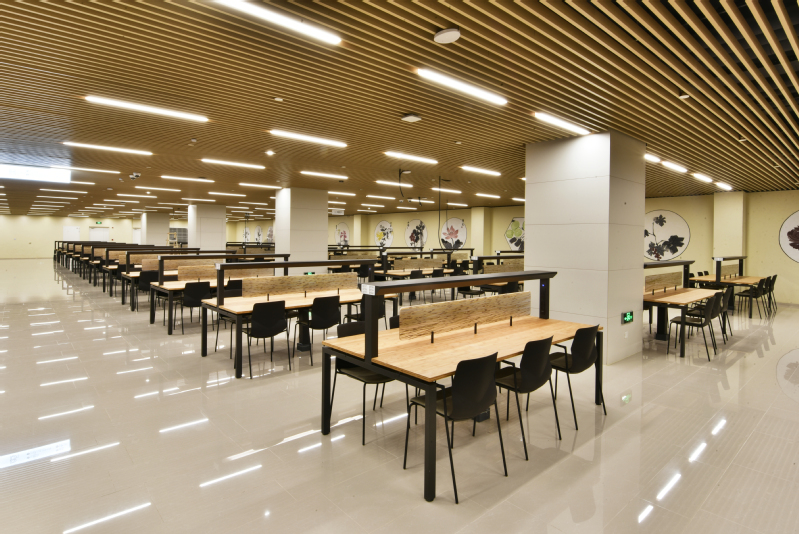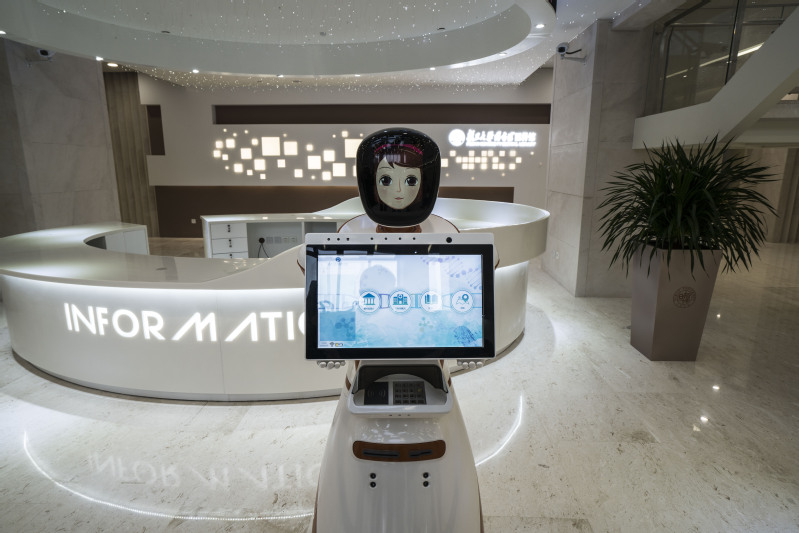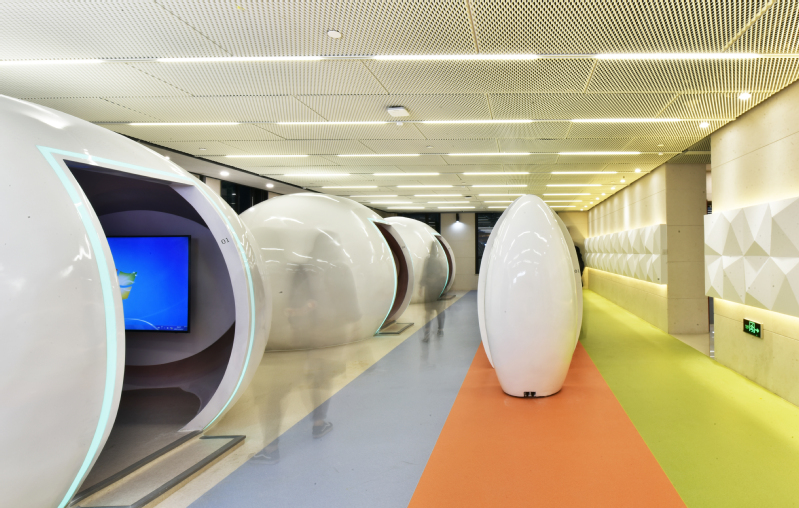Level B1 Level 1 Level 2 Level 3 Level 4 Level 5 Level 6 Level 7

The basement level is a 24-hour unattended self-study space and directly connected to the student apartment.
The study room and 24-hour reading room in this level are equipped with more than 600 seats, and most of them require reservation. Each self-study table is equipped with power supplies, USB sockets and desk lamps, and some self-study tables are also equipped with network cable ports, which is convenient for patrons to use at any time. The bamboo table tops of the self-study tables and the partition screen made of the traditional Chinese medicine tiger grass reflect the environmental protection concept of the medical library.
The 24-hour unattended area provides library patrons with 24-hour self-lending services to best meet their needs.

The first floor is divided into exhibition area, café, lecture hall, reserved book pick-up room, self-service room and an information desk.
The exhibition area, café, and the motion sensing game console outside the security gate are open to the public.
The robot librarian Fu Xiaobai is ready to provide library patrons with simple consultation services at any time. The reserved book pick-up room is available for patrons to pick up their reserved books. There is a 24-hour self-service return window on the west side of the building, which is convenient for patrons to return books during non-library opening hours. A book sorting machine in the self-service room can automatically sort returned books. Patrons can also use the self-service lending machines, the book cleaning and disinfection machine, as well as the printer. If a patron encounters any problems while using the library, he or she can always consult the staff members at the information desk.

The second floor is divided into computer lab, collaborative zone, magazine area, high-tech zone, multimedia room, smart classrooms and book sharing area.
The computer lab is equipped with 18 integrated computers for patrons; the collaborative zone provides multiple sets of discussion tables and chairs. In addition to the adjustable standing/seating tables and chairs, patrons can also reserve collaborative pods with single or dual-screen LCD Monitors for multimedia discussion. There are popular magazines and newspapers for a relaxed and comfortable atmosphere in the magazine area.
The high-tech zone displays a variety of new technologies, such as, VR, AR, 3D printing, providing patrons with immersive learning and practice opportunities; the multimedia room provides three multi-person audiovisual cabins and six single-person audiovisual cubicles for patrons to view film and television materials, such as, classic movies, medical documentaries, and TV series.
The book sharing area on the north side of the second floor houses donated books for patrons to read.

The third floor is divided into the themed book exhibit, reading, Chinese books area, periodical studio and the study rooms.
The themed book exhibit area displays newly arrived books or hosts themed book exhibits; the Chinese book area brings lending and reading functions together and houses monographs in classification numbers from A to R45. The Chinese and foreign print science and technology periodicals are stored in the periodical studio for faculty and student research use. More than 230 reading seats are available in this area, and a self-service lending machine is also available for library patrons.
The research area constitutes group study rooms that are open to reservation for three or more patrons. The six 3-5 person study rooms are equipped with color rewritable walls and sound absorbing walls. Some study rooms are equipped with electronic whiteboards and video equipment to enhance the efficiency of discussion and record the discussion process. The large research room in this area is equipped with movable chairs for group reservation.

The fourth floor is divided into book area, lounge, study rooms, and a meditation zone.
The book area houses Chinese monographs in classification numbers from R47 to Z, foreign language books, and Harvard and MIT textbooks with approximately 100 seats; the lounge is equipped with a sofa set providing patrons with a more comfortable reading space, and this area is also equipped with a self-service lending machine for convenience.
There are six single-person study rooms equipped with tables, chairs and bookcases on this floor. There is also a large study room that can be used for discussion by many patrons.
The imagination zone has a circular sofa set with a semi-closed design to create a care-free and comfortable atmosphere. Patrons can choose single or multiple people seating for inspiration and free thinking.

The fifth floor is divided into an archive of faculty publications and documents of the Shanghai Medical College of Fudan University, teaching reference area, silent reading zones, study rooms, special collections and other areas.
This floor is dominated by Chinese-style design with exhibits displaying special collections of the medical college. The exhibit area displays manuscripts, inscriptions, medical instruments and other valuable objects donated by academicians and well-known professors including Han Qide, Zhou Liangfu, Wen Yumei, Chen Yuzhu, Tang Wei, Yang Xiongli and others.
On the wall of archive, there are 16 statues of the well-known professors. The collections on display are manuscripts and other historical materials of the 16 well-known medical professors at Shanghai Medical College, including valuable collections such as the typewriter used by the founder of the Shanghai Medical College Yan Fuqing. The archive is surrounded by a book wall, and the special collections display a rich publication history.
The teaching reference area stores the teaching reference material designated by professors and has a high usage rate. The wisdom bookshelf facilitates patrons to retrieve books, and the seven-day loan period improves the utilization of these books.
The reference and reading area houses approximately 10,000 printed copies of theses and dissertations of the Master and Ph.D. graduates since 2002.
The silent reading zones provide nearly 100 seats, and reference books. The study room area consists six independent single research rooms and one large research room for reservation.

The sixth floor is divided into workshop space, special exhibit, themed exhibit, media lab, reading area, Zen space and study rooms.
The workshop space is equipped with professional lighting and sound facilities, and the three projection screen walls can respectively display independent content that expands the dialogue space for academic discussion. Currently, the academic discussion area hosts “Fuqing Lecture Hall” series on humanities and the “Inheriting and Developing the Oath of a Doctor” series on medicine and arts knowledge.
The special exhibit area uses sound and pictures to create an all-round immersive viewing experience; the special collections and the themed exhibit collaboratively display various themed exhibitions; the media lab provides professional control stations and recording equipment for faculty and student reservation.
The reading area, Zen space and study rooms are open to patrons in open, semi-closed and closed forms respectively, and they can accommodate more than 100 people simultaneously.
The seventh floor is divided into compact shelving area and office area.
The compact shelves store 80% of the library’s monograph and periodical collections. The compact shelves include manual shelves and smart shelves, which effectively utilize the space and improve efficiency.
The office area includes the library administrative office and subject librarian offices.
